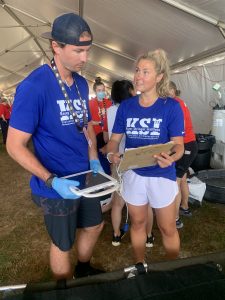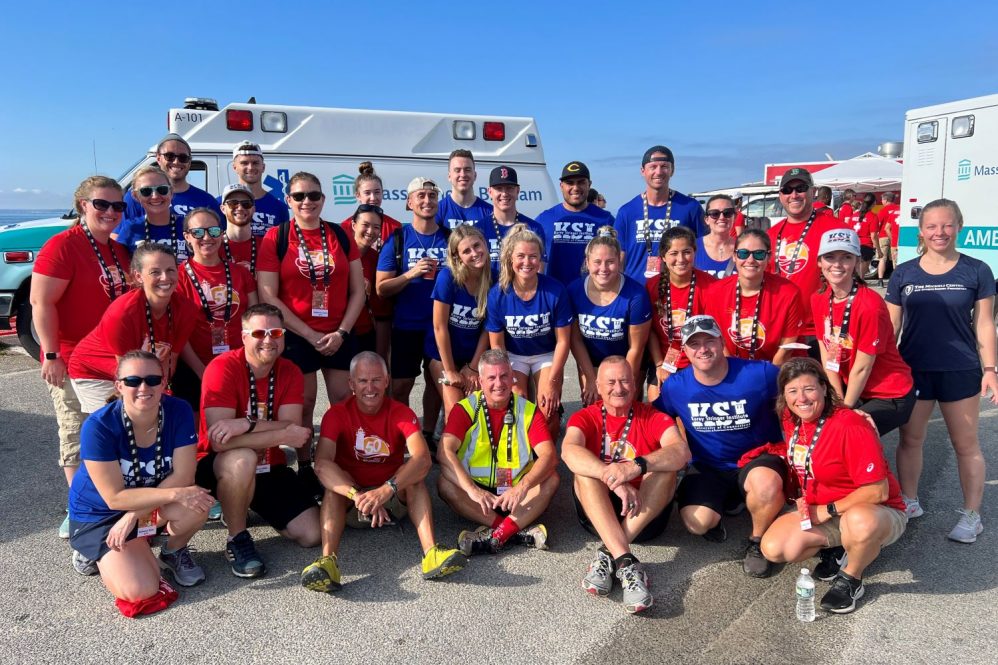Much of the Korey Stringer Institute’s cutting-edge research on exertional heat stroke and thermoregulation happens in their state-of-the-art laboratories. But every year they take their research into the field at the Falmouth Road Race in Massachusetts.
Since 2013, KSI has brought a team of 30 to 40 faculty, staff, and students to the annual seven-mile race to conduct research and provide exertional heat stroke care.
The Falmouth Road Race celebrated its 50th anniversary this year, and the KSI team was there to lend their expertise. Douglas Casa, KSI CEO and professor of kinesiology in the College of Agriculture, Health and Natural Resources, also celebrated a milestone at the race. He first worked in the medical tent in 1994 and has been going to nearly every race since 2000.
“The opportunity to provide medical care and conduct research at the Falmouth Road Race is an incredible opportunity to advance our understanding of human heat physiology and clinical care of exertional heat stroke-one of the 3 leading causes of death for athletes, laborers, and soldiers in training.”

Faculty and graduate student researchers investigated four research questions. The first question looked at the impact of selective serotonin reuptake inhibitors (SSRIs) — commonly prescribed antidepressants – on thermoregulation.
Gabrielle Brewer and Michael Szymanski, the graduate students leading the studies, were interested in this question largely because it is so understudied.
“A lot of the athletic population is on these medications and not a lot of work has been done on [their impact on] thermoregulation,” Szymanski says.
One of the known side effects of SSRIs is that they reduce the amount a person sweats. Since sweating is the main mechanism through which people cool themselves, this may have a significant impact on thermoregulation during an intense outdoor activity like a race.
“We’re one of the first labs to be looking at this in a field setting,” Brewer says. “Regardless of what we find, this will serve as important pilot data for future studies.”
The KSI team also worked with colleagues from Boston’s Children’s Hospital to study the impact of core body temperature on biomechanics – how runners move their bodies during the race.
“When you’re hotter, you get more fatigued and with fatigue, muscles, joints, and different parts of the body don’t work as well,” Szymanski says.
Two other studies looked at the effectiveness of a device that assesses body temperature and a pre-cooling product. The findings from this research will help the companies developing those products determine how far away they are from practical use.
“We’ve been doing research at this race [for years] and every year we’re excited to come back and keep moving forward,” Brewer says. “Our studies grow every year.”
The Falmouth Road Race provides the researchers with a unique field laboratory setting. In their lab, they cannot bring people above an internal body temperature of 104 degrees Fahrenheit for their safety. However, when someone is experiencing exertional heat stroke, their body temperature is commonly over 106 degrees Fahrenheit and may rise as high as 110 degrees Fahrenheit.
“It’s a great opportunity at the Falmouth Road Race to examine [what happens] when people get really really hot at a race naturally,” says Casa. “There’s some fascinating research questions you can look at in those circumstances.”
There is no lack of subjects for the KSI team’s research. The event also provides a unique opportunity to provide life-saving care for heat illnesses.
The Falmouth Road Race sees the most cases of exertional heat stroke of any race in the U.S. This is due to a combination of weather conditions and the race’s length, Casa says.
The race takes place in August each year, one of the hottest months in the Northeast. This year’s race saw a high of 82 degrees and 100 humidity in the morning when the race started. These hot, humid conditions make it harder for runners to sweat and cool themselves effectively.
Additionally, the seven-mile race falls into a kind of “sweet spot” for exertional heat stroke, Casa says. Shorter races, like 5Ks end before runners can get their body temperature elevated to dangerous levels. Longer races, like marathons, require endurance rather than intensity, which helps runners stay cooler.
This year, the team successfully treated more than 30 exertional heat strokes. Casa says that in the 50 years the race has been run, no one treated in the finish line medical tent has ever died of a heat stroke. This sterling track record means people come from around the world to study exertional heat stroke care at this race.
“Clearly the race knows what they’re doing and that’s why people come there to learn how to treat exertional heat strokes,” Casa says.
Casa and the KSI team have already marked their calendars for next year’s race.
Follow UConn CAHNR on social media



